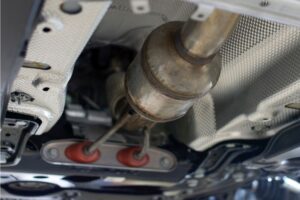You will need to change the engine oil regularly to perform efficiently and make your vehicle run smoothly.
There might have been times when you have seen the oil level warning sign blinking on the dashboard of your vehicle, indicating that there might be an issue or your oil level is low.
This can be dangerous for the functionality of your engine, the performance of your vehicle and even for you and other drivers on the road.
So, can you add oil to a hot engine?
Well, to put it simply, yes, you can. It is stated that adding oil to the hot engine is not harmful.
Although, it will take some time for the engine to cool down and then you can check the oil levels.
Just make sure that you are not exceeding the oil past the line on the dipstick, as that can be dangerous.
In this article, I will be providing you with information regarding engine oil. So you can learn and expand your knowledge further, make sure to read through the whole article.
Table of Contents
Should You Add Oil To A Hot Or Cold Engine?

Many people get confused and even are worried if they put the oil in a hot engine, it might cause some malfunction or something.
But to be honest, it is suggested that it is okay for you to add oil to the hot engine.
This is because the interior part of your engine is made out of heavy-duty metal, which will not get damaged easily.
Moreover, the oil immerses the heat at a slower rate than water, so you will have to wait for a couple of minutes before you can read the oil levels in your engine.
However, some people prefer adding oil to the cold engine, making it easier to analyze the oil level.
Besides all that, just make sure that you are not over filling it with oil as that can cause so many problems for you in the future.
Therefore, only follow the MAX and MIN markings which will have a one-quart difference between them, so it can be easy for you.
By reading those, just be sure that you are not exceeding the MAX mark.
Lastly, you must add new engine oil that matches the one already inside the engine, as mixing two different kinds of engine oil viscosities cannot be good for your vehicle.
Why Is It Necessary To Add New Oil?
This is a crucial step for the functionality of your engine and the efficiency of your vehicle while driving.
Without a touch performing engine, your vehicle would face various problems that will cost you a lot of money for repairing or even replacements.
You must know that a vehicle’s engine is one of the most expensive components of the vehicle, and it can also get damaged easily if not taken care of.
Therefore, always make sure to check the instruction manual provided by your vehicle’s manufacturer to see how regularly you should change your vehicle’s oil.
Moreover, oil change might also be essential if your vehicle is running on low oil levels.
However, if there is an excessive low oil level, then that can be a huge problem, so keep in mind that if you notice that, then you should check for leakage or other problems and get them fixed as soon as possible as they can be problematic.
How To Check The Oil Levels Of Your Vehicle
As I have mentioned earlier, you can check and add oil according to the dipstick, which will have the MAX and Min sign for better understanding.
Most vehicles come with dipsticks that make the job easier, whereas some come with sensors and are not exactly great as they can fail easily.
Therefore, for you to determine the accurate oil levels using a dipstick, the oil level should be approximately in the middle of the two and almost close to and below the Max sign.
Just make sure you are not overfilling it. Furthermore, there are some crucial steps that will help you determine it on your own.
- You should get the performance checked every month or so in order to determine the difference and see how well or bad it is performing so you can make the required changes as soon as possible.
- It is important to keep your vehicle parked on a flat surface and turned off. After this, you would want to wait for a couple of minutes before checking the levels as then it will provide you with better and accurate results.
- Now, you will have to open the hood of your vehicle and locate where the dipstick is placed. If you are a beginner and have little to no idea, then to make it easier for you, the dipsticks are usually in the bright yellow and orange color, so they will stand out from the rest of the components, making it easier to find.
- You will have to pull the dipstick out and make sure to clean it gently from everywhere, leaving no dirt or oil stains. This is because if the dipstick is not clean, it will be giving you the wrong readings.
- After cleaning the dipstick, place it back inside and wait for a couple of minutes again before removing it. This process is essential as it will help you provide accurate readings so you can determine easily. Like I have mentioned earlier, the readings should be in the middle of two and the max line.
- Now that you have your readings, this procedure will help you on what you should do next. If it is low, then you can add the desired amount of oil to level up. Just make sure that you do not end up overfilling it.
How To Change The Oil ,Whether Hot Or Cold Engine?
It is suggested that you should not change the oil when it is extremely hot as that can be too risky and might burn.
You should also not change the oil when it is too cold because it can be difficult in the process of draining it out of the vehicle.
Just make sure to run the vehicle for a couple of minutes and then turn it off since this process will make the draining more easily into the crankcase.
Another thing you should keep in mind is that your vehicle should be parked on a flat surface. With the help of a jack, you can exceed the underneath area of your vehicle comfortably.
Now you will have to use the drain pan to remove all the oil. Put the drain plug on again and keep it in place once the oil drains. You will now have to change the oil filter as well.
Do this by using a filter wrench, moving it counterclockwise, and then finally remove the filter.
Make sure to apply motor oil to the new filter so that it does not crack easily or stay stuck and tighten it securely as it should be.
Make Sure To Check The Instruction Manual
Once you are done with removing all the old oil from the vehicle as well as installing a new filter, it is time for you to change the vehicle oil to a new one.
When it comes to changing the vehicle’s oil, if this is your first time doing it, then it is crucial to check the instruction manual provided by your vehicle’s manufacturer as they know better which oil will work best on your vehicle.
However, if you already know which oil is best for you, then you should stick to the same one as before, or if you think there are some problems, then you should also read the manual.
Different Oil In Different Seasons
Do keep in mind that during different seasons you should use different kinds of oil, such as during winters.
Make sure to use lower viscosity oil, and during summer, use higher viscosity oil.
It is worth mentioning that you should not use thin oil for your vehicle as that can damage the engine because if the oil is really thin, then it will not function or lubricate the internal material of the engine.
Moreover, if your vehicle is a newer model, then it is best to use synthetic oil, whereas if your vehicle is an older model, then traditional is way better.
Here’s the related article you would like to read about Best Motor Oils For Hot Weather if you live in a hot area.
Be Careful With All The Steps
Now that you also know how to change the oil, just be careful that you are following the steps accordingly.
If you make the mistake of missing a step or doing one step before or after the other, then that can leave you confused and will not provide you with the results you expected.
Do change the oil every once in a while according to the manual provided because it will keep the engine strong and maximize the lifespan, which will eventually improve the performance of your vehicle.
Why Would Your Vehicle Need Oil?
The answer is simple, if there is no oil running inside, then that can cause huge damage to the engine and other components inside your vehicle.
Oil is an essential tool for the functionality of the engine. Without the oil, the parts that are inside the vehicle will not lubricate well.
This can lead to bigger problems and can cost you a lot of money for repairs. Moreover, when you are driving, there are metal parts that will be pounding with one another.
This is why the oil is vital for the lubrication of these parts to run smoothly, or else it can be harmful to your vehicle.
One way to fix this issue is by running the vehicle and letting the engine get warm, which will allow the oil to spread around the engine.
The oil does not only lubricate the metal parts of the vehicle but also protects the engine from overheating as well as clean out any dirt and debris that might attach inside the vehicle.
Conclusion
Now that you have a better idea regarding whether can you add oil to a hot engine or not. You can comfortably make the right decision without the fear of damaging your vehicle’s engine.
Remember that it is also necessary to change the engine oil regularly as well as keep it maintained, so it provides you with the best performance when you are on the road.
Besides all that, the engine is one of the most crucial fluids for your vehicle, so refill it as soon as possible whenever it is running low, even if the engine is hot, as it will not damage anything inside or out.

I am Tahir Azam, and I have been writing amazing articles for TaxiHack for as long as I can remember. I know everything that is to know when it comes to automobiles and is always on top of industry news and developments. While I am not an expert by any means, I pride myself on knowing the ins and outs of many different problems and, of course, their solutions. The articles on our website are some of the best and well-researched content that you will find, and I spend countless hours making sure this remains to be true. This is why I ask you to take your time out and read some of my articles, especially if you find a topic that resonates with you or is something you are looking into. This way, you will find the perfect mix of information and tips on your desired topic. Learn more about Tahir.


